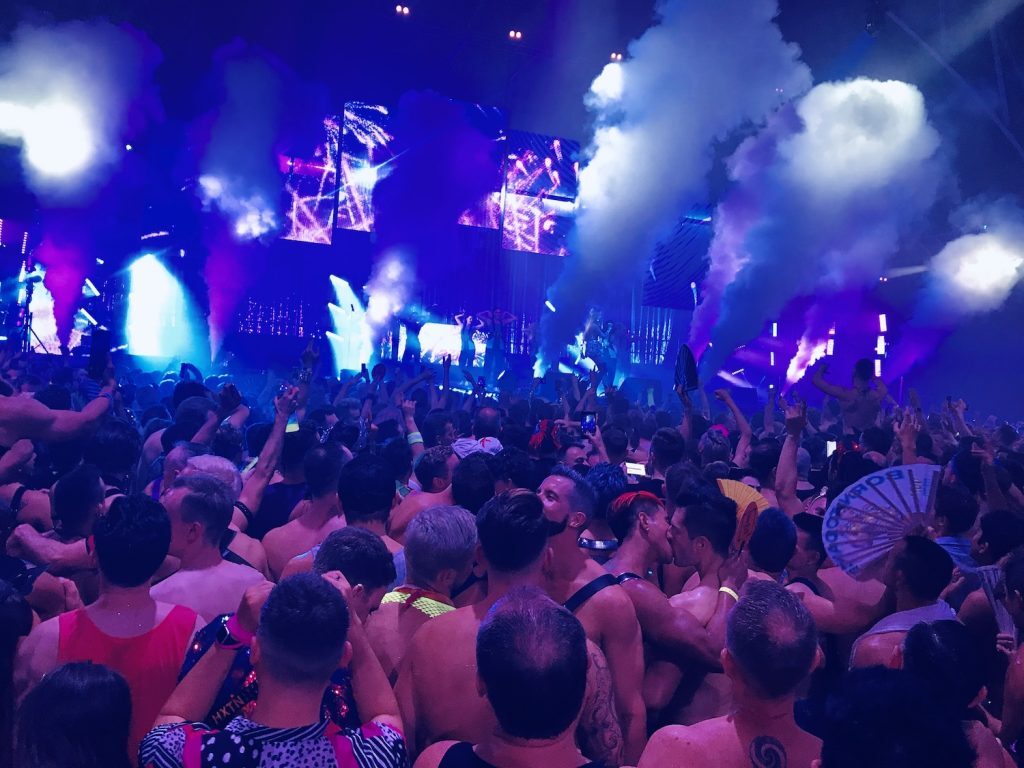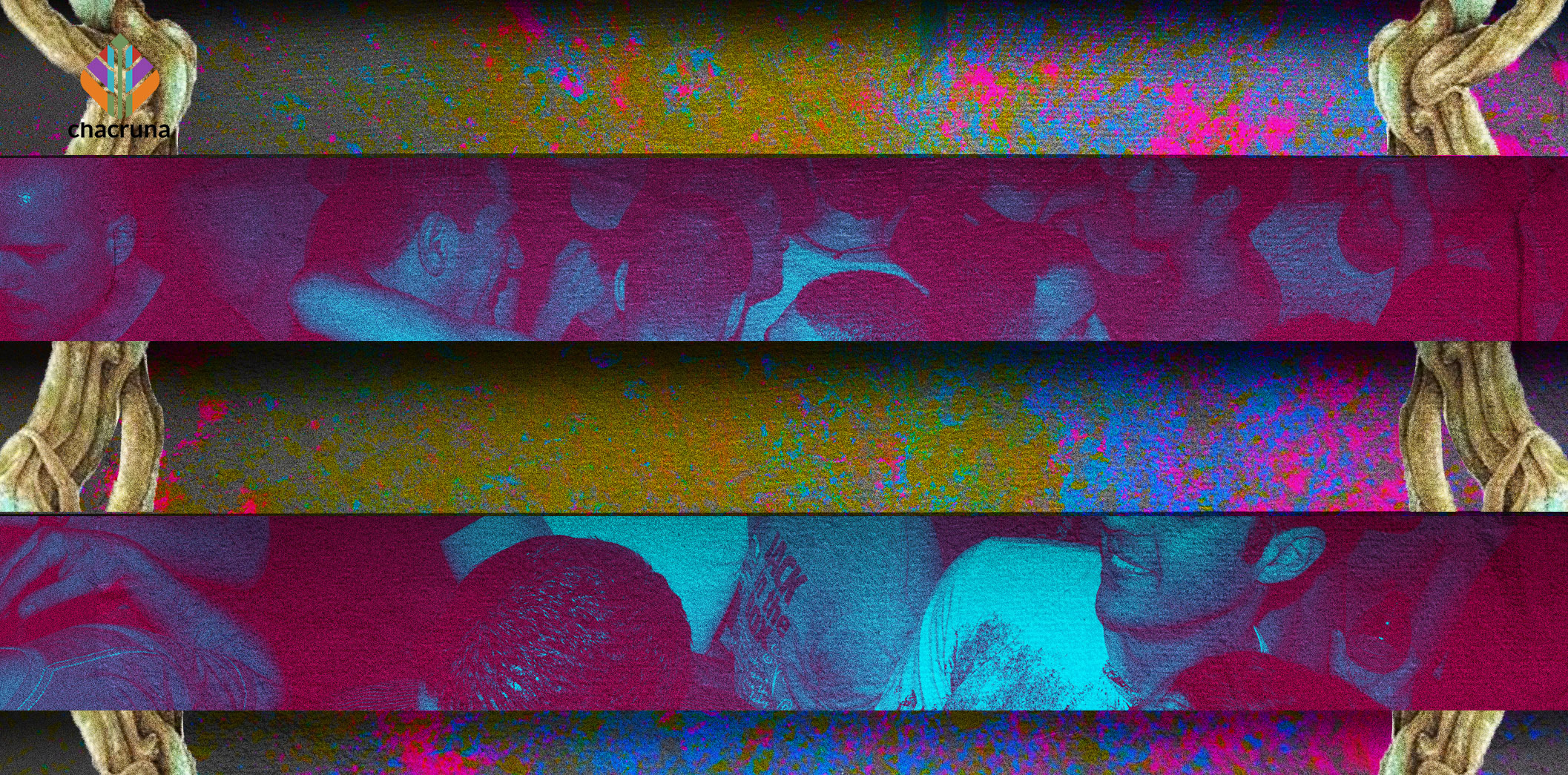- How Psychedelics Can Guide the Transformative Journey of Polyamory - April 2, 2024
- Jeering Psychedelics: A Critique of Jacques Mabit’s Criticism of Queering Psychedelics - February 4, 2022
- How Ayahuasca Can Help Gay Men Create Better Dance Parties - June 17, 2021
I gazed across the sea of undulating bodies glistening with sweat. Never had I seen so many gorgeous men, each one radiating lust. I could feel my MDMA kick in. The warm tingles in my body blended with the pulsing music to unlock a tribal desire to lose myself in a dance of merged flesh. I had dedicated months at the gym to prepare for this union. As I stepped into the crowd, I prayed my hard work would allow me to join the inner circle.
Through ayahuasca ceremonies, another form of communal ritual, I learned how to craft more fulfilling experiences at these parties.
Gay men’s dance parties are communal rituals that carry the potential for deep healing, both individually and as a collective. However, wounds from the closet create an atmosphere of exclusion that can harm instead of heal. Through ayahuasca ceremonies, another form of communal ritual, I learned how to craft more fulfilling experiences at these parties. I hope my journey will benefit you as well.
Gay men dance together in a variety of spaces. In this article, I focus on electronic dance music parties where there are few to no women present, the atmosphere is explicitly erotic, and the majority of partygoers supplement their experience with some combination of MDMA, Ketamine, and GHB. This type of party is distinctive in the gay community.
Discover the Indigenous Reciprocity Initiative of the Americas
The Healing Power Of Collective Dance
Even without the aid of substances, collective dance induces a trance-like state of consciousness that “mobilizes emotions associated with repressed memories, brings them to the surface, and facilitates their expression”
Dancing with one’s tribe for healing purposes transcends time and culture (Grof & Grof, 2010). Even without the aid of substances, collective dance induces a trance-like state of consciousness that “mobilizes emotions associated with repressed memories, brings them to the surface, and facilitates their expression” (p. 33). In his seminal book on trauma, The Body Keeps The Score, psychiatrist Bessel Van Der Kolk (2014) poignantly describes one such example:
Then one of the women started to hum, while gently swaying back and forth. Slowly a rhythm emerged; bit-by-bit other women joined in. Soon the whole group was singing, moving, and getting up to dance. It was an astounding transformation: people coming back to life, faces becoming attuned, vitality returning to their bodies. I made a vow to apply what I was seeing there and to study how rhythm, chanting, and movement can help to heal trauma. (p. 214)
The healing power of collective dance extends beyond the personal. “Sharing non-ordinary states of consciousness in a ritual context leads to the development of a sense of community” (Grof & Grof, 2010, p. 49). It is no wonder, then, that “most of the music scenes that founded today’s dance music genres—disco, garage, house, etc.—were closely connected with marginalized groups, including gays and lesbians, transpeople, [and] racial and ethnic minorities” (Garcia, 2014, para. 3).
It makes sense that gay men holding the collective traumas of hiding in the closet, racism, homophobia, and AIDS would gravitate to collective dance. It is also not surprising that the primary substances men use at dance parties include MDMA and Ketamine. Unlike other party drugs like alcohol or cocaine, these substances induce healing states of consciousness that “move us towards greater sensitivity, awareness, and compassion for ourselves and our fellow travelers on the planet” (Ziegler, 2016, p. 52).
It is a testament to our creativity that gay men would create dance parties with the capacity to strengthen our community and heal our traumas. Unfortunately, as I will discuss, our dance parties can harm as well as heal.
Wounds From The Closet Create An Atmosphere Of Exclusion
In his book The Velvet Rage, psychologist Alan Downs (2005) describes how life in the closet wounds a gay man’s sense of worthiness. At a tender age, we absorbed the belief that we are unacceptably flawed. To offset overwhelming shame, “we learned to split ourselves in parts, hiding what wasn’t acceptable and flaunting what was” (p. 21).
Believing there is not enough room at the table for everyone, we often compete with each other for crumbs of validation instead of freely sharing what could be a banquet of love.
Although many of us eventually came out of the closet, shame is still wired into our brains (Downs, 2005). As adults, our need to avoid that shame compels us to elicit approval “by being more successful, outrageous, fabulous, beautiful, or masculine” (p. 4). Believing there is not enough room at the table for everyone, we often compete with each other for crumbs of validation instead of freely sharing what could be a banquet of love.
This broad generalization certainly does not apply to every gay man. However, my personal observations as a gay man and as a psychotherapist confirm the undercurrent of competitiveness and exclusion in our community. We tend to view others on a hierarchy of physical attractiveness, popularity, and status. We then judge our own worth based on our position on that hierarchy. This plays out commonly through sex. I regularly hear gay men express that their desire for sex often springs not from arousal but a desire for validation from men they place on a pedestal.

Gay men’s dance parties magnify this phenomenon. In another Chacruna Institute article, psychotherapist Kylea Taylor (2019) describes how expanded states of consciousness intensify our existing vulnerabilities. “Spiritual longings and fears get mixed up with personal desires and fears in a confusing package. For example, a personal desire for sex may include a spiritual longing for mystical merging and spiritual union” (para. 9). As we dance together in expanded states, our desires for sex, validation, and inclusion take on a profound quality. Other men can appear god-like. Their acceptance feels like basking in universal love whereas rejection can trigger shame and isolation.
We Reach Our Potential Through Co-creation
I have a complicated relationship with these parties. On one hand, they helped me find a gay community and initiated my love of collective dance. On the other, I have always sensed the absence of a vital element. It was not until I started participating in Ayahuasca ceremonies that I discovered the missing ingredient: co-creation.
In ayahuasca ceremonies, we create our experience together in an interconnected web of relationship. “What I do affects you. What you do affects me. What I do to you will ultimately affect me. What you do to me will ultimately affect you” (Taylor, 2017, chap. 2, para. 25). In a co-creation, we naturally appreciate and are generous with each other because our experiences are woven together.
In contrast, gay men’s dance parties are highly transactional. We pay money to consume an experience without participating in its creation. We are even transactional with each other. Each person can become a commodity, easily disposed of for the potential of someone better. My goal is not to disparage our dance parties. Instead, I wish to share some ways co-creation has helped me improve my experience.

Recordings are now available to watch here
Create A Container of Connection
In ayahuasca ceremonies, it is common to create a group “container” for the experience by opening and closing it with connection. Before the ceremony begins, we usually sit in a circle and share our intentions. The next day, we sit in circle again and share our journeys with each other. These circles help the ceremony feel more intimate.
You might enjoy dance parties more if you include a container of connection. If you and your friends are pre-partying together, take a moment before heading out to circle up. Take turns briefly sharing your mental space. How are you feeling? What highs and lows have you faced lately? Do you have any hopes or fears around the party? If no one is meeting up in advance, connecting over Zoom or group text can also work. Even brief check-ins help parties feel more connected.
To close the container, check back in with each other as a group the next day. You can do it virtually or over brunch. Share what the party was like for you and any joys or challenges. Going over the experience again will help you process it, and the human connection will help soothe any parts of you that feel raw. This is particularly helpful if your serotonin is depleted.
Focus On Offering Instead of Craving
When a throng of men awakens your primal hunger, it is easy to focus on what you lack rather than what you have. Expanded states of consciousness can magnify those vulnerabilities into an intense craving (Taylor, 2019).
How do you react when the craving hits? Do you lead with your sexuality to lure others in? Do you guard your energy by ignoring those who seem beneath you? Whatever the strategy, acting out of craving creates an impersonal atmosphere in which other people are a means to an end.
My experiences of co-creation in ayahuasca ceremonies have shown me that the best way to free yourself from craving is to focus on what you can offer others.
My experiences of co-creation in ayahuasca ceremonies have shown me that the best way to free yourself from craving is to focus on what you can offer others. Offering creates a sense of abundance and connects us to our common humanity.
There are plenty of ways to make offerings at parties. Start by offering warmth to more than just those you find attractive. You can still get sexual, but try not to let craving dictate every interaction. Similarly, offer others more than just your sex appeal. I will never forget the night my friends and I brought body paints to a dance party and offered decorations to everyone. The joy was palpable as people connected over each other’s designs. What might you offer others? Will you give bear hugs? Spray fragrant water infused with essential oils? Create a light show? Imagine what our parties could become if we each invested in co-creating them.

Let It Out
My final suggestion for co-creating more gratifying dance parties is to “let it out.” In ayahuasca ceremonies, we weep, laugh, and often vomit—known as purging—profusely. In expanded states of consciousness, “it is essential to surrender completely to the flow of music, let it resonate in one’s entire body, and respond to it in a spontaneous and elemental fashion” (Grof & Grof, 2010, p. 34).
At our dance parties, I often feel social pressure to conform. When everyone else is bobbing in unison to the music, more expressive forms of movement can earn quizzical looks. Similarly, creative outfits tend to stand out like a sore thumb when the unspoken dress code is jeans with no shirt.
Play big! You came to the party to feel joy, and its source is inside you. When you let your authentic self out, you give others permission to do the same. Even if you like to fly under the radar, show warmth to those who take risks. Together, we can co-create an explosion of happiness.
Will You Join the Party?
My experience of gay dance parties has changed over the years. In the past, they felt like exclusive clubs that lavished rewards on people based on their desirability. Now, I take a different approach. I co-create. By connecting instead of competing, offering instead of craving, and letting my authentic self out, I create more fulfilling experiences for myself and those around me. Will you join me?
Art by Karina Alvarez.
References
Downs, A. (2005). The velvet rage: Overcoming the pain of growing up gay in a straight man’s world (2nd ed.). Boston, MA: Da Capo Press.
Garcia, L. (2014, January 28). An alternate history of sexuality in club culture. Resident Advisor. https://ra.co/features/1927
Grof, S., & Grof, C. (2010). Holotropic breathwork: A new approach to self-exploration and therapy. Albany, NY: State University of NY Press.
Taylor, K. (2017). The ethics of caring: Finding right relationship with clients. Santa Cruz, CA: Hanford Mead.
Taylor, K. (2019, April 26). Our vulnerabilities to unethical sexual behavior. Chacruna. https://chacruna.net/our-vulnerabilities-to-unethical-sexual-behavior/
Van Der Kolk, B. A. (2014). The body keeps the score: Brain, mind, and body in the healing of trauma. New York City, NY: Viking.
Ziegler, M. (2016). Ketamine: A transformational catalyst. MAPS Bulletin, 26(3), 51–53. https://maps.org/news/bulletin/articles/410-bulletin-winter-2016/6470-ketamine-a-transformational-catalyst
Take a minute to browse our stock:
Did you enjoy reading this article?
Please support Chacruna's work by donating to us. We are an independent organization and we offer free education and advocacy for psychedelic plant medicines. We are a team of dedicated volunteers!
Can you help Chacruna advance cultural understanding around these substances?


















